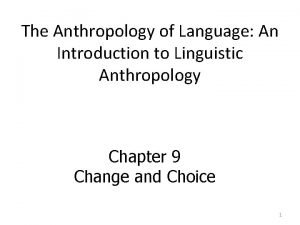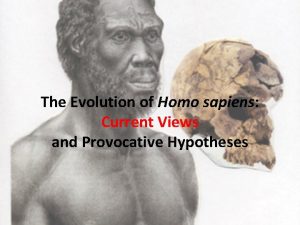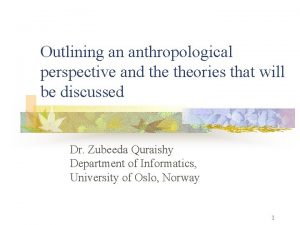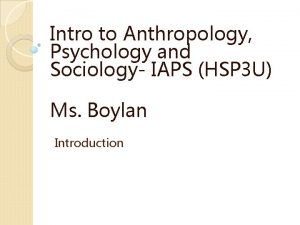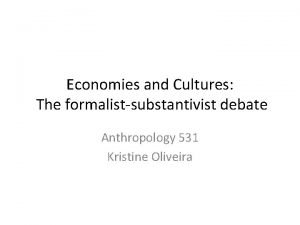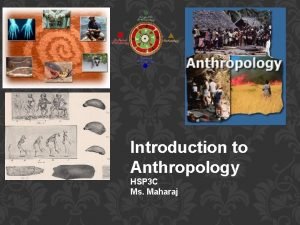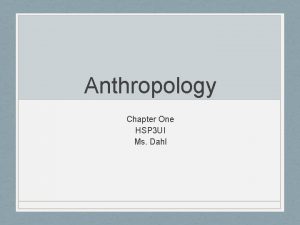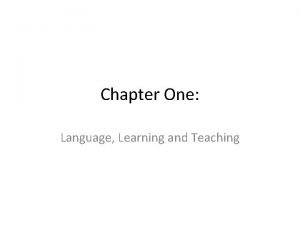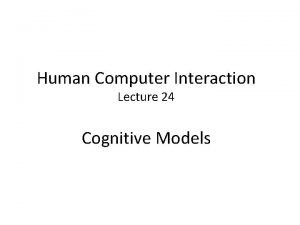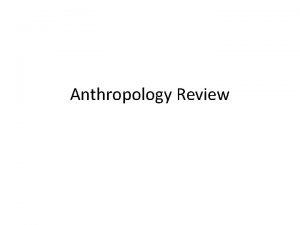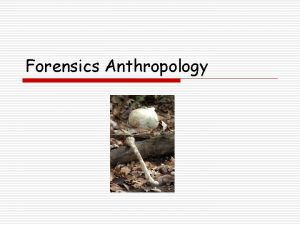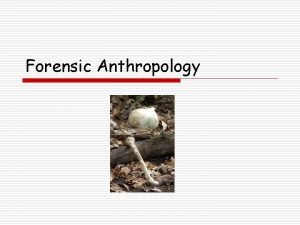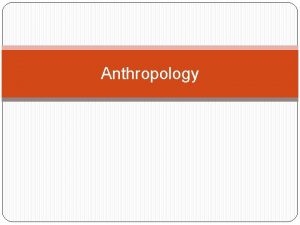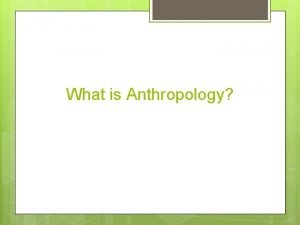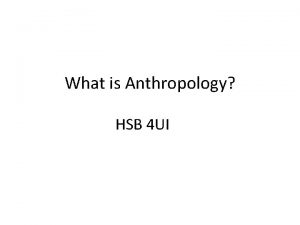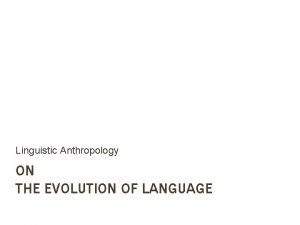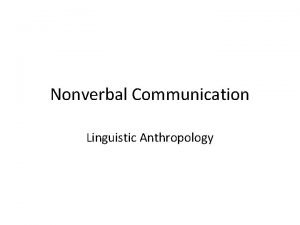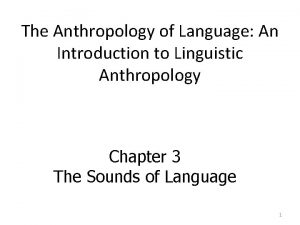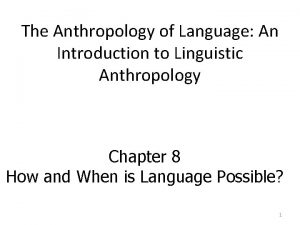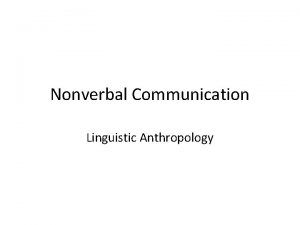Linguistic Anthropology Language and Culture Culture In 1952






















- Slides: 22

Linguistic Anthropology Language and Culture

Culture • In 1952, Alfred Kroeber and Clyde Kluckhohn, published a book containing 164 definitions of culture taken from the published work of anthropologists. • Still no universally accepted definition • One widely used definition (thanks to Max Weber and Clifford Geertz): Culture is a web of meaning which human beings weave and in which we are suspended.

The emic vs. etic distinction • From Phonetics vs Phonemics • Two equally valid perspectives from which to view human behavior, activities, values, etc. • Emic—subjectively relevant, internally verifiable • Etic—objectively identifiable, externally observable

Etic and Emic – an example • Etic data—things that are observable – 110° F water into mug, water swirled in mug, water poured into the sink, drink poured into mug • Emic data—the meaning of the action for the actor – He warms his coffee mug so that the coffee tastes better » Or – She tries to kill all the germs and bacteria that have accumulated in the coffee mug since its last washing

Ethnosemantics • 1950 s and 60 s • Frake, Goodenough, Conklin • Alternate names: – Ethnoscience, Cognitive Anthropology • Vocabulary indicates – “native” categories – Culturally important distinctions • Psychological reality or formal account?

Cultural emphases – What IS subjectively relevant? • Cultural emphases reflect activities, meet needs • Some universal patterns appear to exist, however • Color terms – Stages 1 -7 • Color terms and focal points (Berlin & Kay) – Codability—how easy is it to name a color chip – Availability—how easy is it to find a given chip in a group of other chips

Standardized Color Chart

Color terms – Stages 1 -7 • Stage 1: black & white • Stage 2: black, white & red • Stage 3: black, white, red & green or yellow • Stage 4: black, white, red, green & yellow • Stage 5: black, white, red, green, yellow & blue • Stage 6: black, white, red, green, yellow, blue & brown • Stage 7: black, white, red, green, yellow, blue, brown & purple, pink, orange, and/or gray

Getting at the Emic – Doing ethnosemantic research • Creating a taxonomy – Asking questions about relationships: • Is X a kind of Y? • What other kinds of Y are there? • Are there other kinds of X? – Taxonomy about relationships • Componential analysis – Discovering key differences

Sapir-Whorf or Whorfian hypothesis: two versions • Strong Whorf—language determines thought, you think within the structure of your language – Agar—language as prison • Weaker Whorf—language provides habitual patterns of seeing, thinking and talking – Agar—Language as a familiar room; you know where everything is in it • Both forms of linguistic determinism

Linguistic Determinism • Origins – “Human beings. . . are very much at the mercy of the particular language which has become the medium of expression for their society. ” (Sapir 1929) – “we cannot talk at all except by subscribing to the organization and classification of data” (Whorf 1940)

Examples of Linguistic Determinism: Standard American English (SAE) • time = matter • units of time = objects • passage of time = endless line of identical objects

Examples of Linguistic Determinism: Hopi • time = a process • units of time = cycles • passage of time = endless repetition of same cycle

Experiments in Linguistic Determinism • Yucatec – Grammar stresses material • Connects words for wood, tree, table – Individuals group cardboard items together • English – Grammar stresses shape • Different words for wood, tree, table – Individuals group boxes together

Experiencing Linguistic Determinism • Temporary transfer of control – English—lend/borrow – Shinzwani—kopa • Telling time – English—it is half past nine – Czech—it is half of ten • Relative vs. absolute space – English—deictic system – Guugu-Yimidhirr—absolute system

Experience and imagination • Metaphor—a figure of speech in which a term or phrase is applied to something to which it is not literally applicable in order to suggest a resemblance • Metonymy—a figure of speech that consists of the use of the name of one object or concept for that of another to which it is related, or of which it is a part • Frame—a system of expectations which influences experience

Metaphors in SAE – a set of examples • Anger as Body heat – I have a hot temper. • Body as container of emotions – I am just about up to here! – He was filled with grief. • Body as container for emotions plus Anger as heat = – Heating fluid in a container • He was boiling mad. • She was fuming. • I was steamed. – Dealt with by cooling or containing • A good workout always helps her cool her temper. • I keep my anger bottled up. – Potential for explosion, in which things go up • I blew my top. • She hit the ceiling. • He went right through the roof.

Metonyms in SAE – some examples • Friends, Romans, countrymen, lend me your ears. • Yesterday, the White House announced… • Wall Street reacted badly to the news from Europe. • My knee is killing me. • If you like it then you should-a put a ring on it.

Frames – structures of expectation we use to make sense of the world • Frames make use of, and make sense of, metaphors and metonyms • Frames trump facts (Lakoff); they make it difficult to absorb things that don’t fit • Examples: – The restaurant – The classroom

The significance of frames • “gay marriage” or “same-sex marriage” • “looting” or “finding” • “the rich” or “job creators” • “quiz” or “assessment” • “date” or “hook-up”

Coping with differences • Using the one you are in is easier than trying to translate concepts • Translation, if it requires completely identical meanings, is frequently not possible • The system you are in will shape your perceptions, however • Human beings construct the systems of meaning which shape our perceptions • You are ALWAYS in a system of meaning, but you are not trapped in any particular system of meaning

Summary • Language is a window into culture (Boas) • Language is a cultural map (Conklin, Frake…) • Language is a guide to social reality (Sapir/Whorf) – Linguistic relativity: grammar influences thought • A well-accepted idea – Linguistic determinism: grammar determines world view • Still controversial • Language is a framing device (Lakoff) – Helps us to organize and frame our experience of the world – And to express our experience of the world
 Linguistic anthropology example
Linguistic anthropology example The anthropology of language
The anthropology of language Lumpers and splitters anthropology
Lumpers and splitters anthropology Anthropological perspective
Anthropological perspective Anthropology psychology and sociology
Anthropology psychology and sociology Substantivism vs formalism
Substantivism vs formalism Sociology psychology and anthropology venn diagram
Sociology psychology and anthropology venn diagram Hsp 3c
Hsp 3c Introduction to anthropology psychology and sociology
Introduction to anthropology psychology and sociology Anthropology and its branches
Anthropology and its branches Linguistic inquiry word count
Linguistic inquiry word count Pragmatics examples
Pragmatics examples Generative linguistics and cognitive psychology
Generative linguistics and cognitive psychology Linguistic varieties and multilingual nations
Linguistic varieties and multilingual nations Task action grammar is based upon bnf
Task action grammar is based upon bnf Cultural relativism definition
Cultural relativism definition Fed-batch
Fed-batch Difference between american and indian culture
Difference between american and indian culture Uses of selenite f broth
Uses of selenite f broth Folk culture and popular culture venn diagram
Folk culture and popular culture venn diagram Leisure
Leisure Tsi
Tsi Folk culture and popular culture venn diagram
Folk culture and popular culture venn diagram

